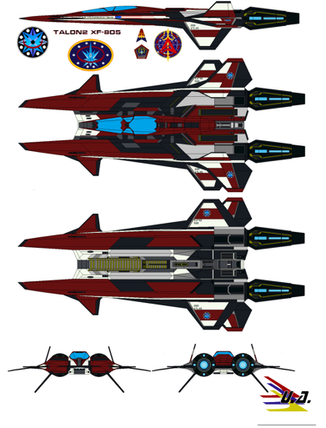HOME | DD
 bagera3005 — VF-4 Lightning III
by-nc-nd
bagera3005 — VF-4 Lightning III
by-nc-nd

Published: 2008-06-21 18:39:36 +0000 UTC; Views: 13553; Favourites: 112; Downloads: 562
Redirect to original
Description
Stonewell Bellcom VF-4 Lightning IIITechnical Data
Equipment Type: UNS/UNSM main variable fighter
Government: U.N. Spacy, U.N. Space Marines
Manufacturer: Stonewell/Bellcom
Introduction: 2012
Operational Deployment: September 2012
Accommodation: pilot only
Dimensions:
# Fighter Mode: wingspan 14.28 meters; height 3.72 meters; length 14.92 meters
# GERWALK Mode: wingspan 14.28 meters
Mass: empty 13.95 metric tons
Structure: space metal frame, energy converting armor
Power Plant: two Shinnakasu/P&W/Roice FF-2011 thermonuclear turbine engines (VF-4G features Shinnakasu/P&W/Roice FF-2011(+) thermonuclear turbine engines).
Propulsion: 14,000 kg [x g] x 2; P&W HMM-1A high-maneuverability vernier thrusters (VF-4G features 16,500 kg [x g] x 2).
Performance:
# Fighter Mode: at 10,000 m Mach 3.02; at 30,000+ m Mach 5.15 (VF-4G performance is Mach 3.25 at 10,000 m and Mach 5.33 at 30,000+ m)
g limit: unknown
Design Features: 3-mode variable transformation; wing-mounted engines; canard forward wing; inward-canted vertical stabilizers; nose-mounted ventral fin; two-dimensional thrust vectoring.
- Armament -
Guns:
# 2 x large beam cannons (mounted in forward engine nacelles/lower arms in GERWALK and Battroid modes)
Bombs & Missiles:
# 6 (with a maximum of 12) x semi-recessed long range missiles (mounted on engine nacelles and ventral fuselage)
# 2 x underwing pylons for missiles
Optional Armament:
# 1 x Howard GU-11 55 mm three-barrel Gatling gun pod with 200 rds fired at 1,200 rds/min
Description and History
The VF-4 Lightning III began development in 2005 under the initial designation of the VF-X-4. The concept behind the VF-4 was to develop a variable fighter that would take advantage of the powerful beam weaponry discovered during research of OverTechnology. The early VF-X-4 shared a similar nose to the VF-1 and was shorter in length (using up to 35% VF-1 Valkyrie parts), but eventually the design was altered. The nose became lengthened and the frame was reduced to a more flattened wing, though the craft maintained similar shape overall and the distinctive wing-mounted engine nacelles. VF-X-4 underwent flight tests, including being test piloted by Space War I veteran Hikaru Ichijo. Once successful operational models were ready, the VF-4 began mass production on February 2012. Initial deployment began on the SDF-2 Megaroad-01 in VF-1 Skull and SVF-184 Iron Chiefs Squadrons on September 2012. When the SDF-2 Megaroad launched in the same month, Hikaru Ichijo flew a VF-4 along side the new colonization vessel as the ship lifted from Earth and began exploration outside of the Sol system.
Built to utilize beam cannon technology, the VF-4 primary weapons became two large beam cannons, though the craft is capable of carrying a GU-11 gun pod in GERWALK and Battroid modes. In addition to the powerful primary beam guns, the Lightning III also featured six, semi-recessed long-range missiles (with mountings for up to twelve) as well as underwing pylons for additional missiles. The VF-4 was only slightly heavier than the VF-1, but featured considerably more powerful engines making the craft ideal for operations deeper out in space. The Lightning III was also much faster in the atmosphere than the older VF-1 though some U.N.S. analysts (with evidence from flight records) have noted the VF-4 delta wing would make the craft less maneuverable at lower speeds than the VF-1. Others have countered that the VF-4's semi-recessed missiles produce less drag than underwing pylons of the VF-1 and that the VF-4 canards and thrust vectoring make the craft as maneuverable as the VF-1 at transonic and supersonic speeds. The VF-4 is also notable as the first production variable fighter to utilize a HOTAS system (Hands On Throttle And Stick) for the cockpit HMI (Human-Machine Interface). The VF-4's cockpit was also built as a single hexagonal MFD (Multi-Function Display) that proved so successful it was retrofitted into "Block 6" VF-1 fighters as well as providing the template for all future variable fighter cockpits. Fully transformable, the VF-4 could shift into Battroid and GERWALK modes like previous variable fighters.
By the end of 2015, mass production of the VF-1 series at last came to an end. From 2020 onward, the VF-4 Lightning III officially replaced the VF-1 to become the main variable fighter of U.N. Forces. Production of the VF-4 continued for a decade and ceased in 2022 with a total of 8,245 Lightning III variable fighters produced. While the fighter remained in active service well into the late 2040's, the VF-4 Lightning III was eventually replaced as the main variable fighter of U.N. Forces in the later half of the 2020s by the VF-5000 Star Mirage.
Production Notes
Debut: Macross Flashback 2012
Pilot(s): Hikaru Ichijo
Other appearances: none.
Original mechanical designer: Shoji Kawamori
Related content
Comments: 7

nice shame its only shown once in the end of the robotech movie
👍: 0 ⏩: 0

























